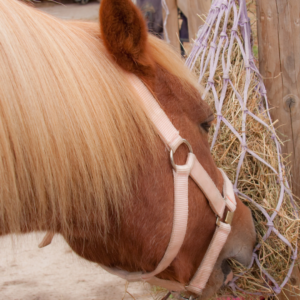 Pros and Cons of Using Haynets: New Information. For every good reason to manage a horse in a particular fashion there seems to be an equally compelling argument to not take that approach. Take haynets, for example. Haynets can be beneficial in some management scenarios. However, a new study suggests they may increase a horse’s risk of neck or back injury.*
Pros and Cons of Using Haynets: New Information. For every good reason to manage a horse in a particular fashion there seems to be an equally compelling argument to not take that approach. Take haynets, for example. Haynets can be beneficial in some management scenarios. However, a new study suggests they may increase a horse’s risk of neck or back injury.*
Benefits of Haynets:
Feeding horses from haynets reportedly slows feed intake. This allows horses to consume forage for longer periods of time than when forage is spread on the ground. Prolonging forage intake mimics the time spent on pasture, where horses typically allocate 12-18 hours a day to grazing and foraging. Thus, using haynets to extend feeding times more closely matches natural grazing behavior of horses.
“Extended feeding or foraging means the horses’ stomachs are not empty for extended periods of time, which is important for reducing the likelihood of developing equine squamous gastric disease or ESGD,” said Ashley Fowler, Ph.D., a nutritionist for Kentucky Equine Research.
“Forage creates a ‘splash guard’ so acidic gastric fluid doesn’t damage the wall of the stomach in the less protected upper or squamous region of the stomach,” she added.
Horses at risk of ESGD, such as those on high-grain diets or those fed only two or three meals a day, would therefore benefit from haynets to ensure the presence of that splash guard. These horses would also benefit from a gastric buffer.
According to Fowler, managing appropriate body condition in horses also helps reduce the risk of insulin resistance, laminitis, and equine metabolic syndrome.
“For horses that are overweight, decreasing the amount of forage offered may be necessary to encourage weight loss. Haynets can help slow the rate of consumption when owners need to restrict forage intake, which can help avoid stereotypies, such as wood chewing and bedding consumption,” Fowler added.
Disadvantages of Haynets
Suspending the hay net at head level does not mimic the natural position of the head and neck during pasture grazing. When horses consistently eat with their heads elevated, the nasal passages do not drain. This potentially puts horses at risk for respiratory infections. Further, hay is often dusty and having horses bury their muzzles in haynets may induce an asthma flare-up.
“A new study measured the pull forces that occur when horses grab forage from small-hole haynets. Pull pressures were measured by attaching the haynet to a pull gauge, which measured the forces in Newtons,” explained Fowler.
Interesting findings in that study included:
- Pull forces were higher for hay hung in double or layered haynets compared to a single net;
- Horses pulled harder when the haynet was hung at a lower position. In the low position, the haynet was about an inch above the withers; in the high position, it was a foot above the withers (closer to face level); and
- Pull forces differed depending on whether hay or haylage (with a higher moisture content) was offered. Horses pulled harder with haylage.
“These pressures may cause some wear on the dental and musculoskeletal system,” wrote the researchers. However, further study is needed to further define the pull pressures on neck and back pain while using haynets.
“Haynets are great for horses that need to increase the amount of time spent eating. This study suggests that perhaps haynet height and hole size should be considered to reduce potential strain on the musculoskeletal system,” concluded Fowler.
Resources:
Questions about the Pros and Cons of Using Haynets? contact J & J Hay Farms today at 770-887-0440!
*Hodgson, S., P. Bennett-Skinner, B. Lancaster, S. Upton, P. Harris, and A.D. Ellis. 2022. Posture and pull pressure by horses when eating hay or haylage from a hay net hung at various positions. Animals (Basel) 12(21):2999.
